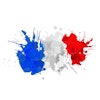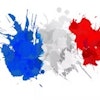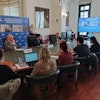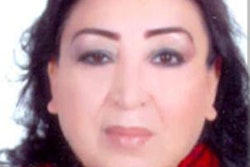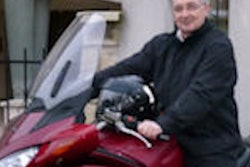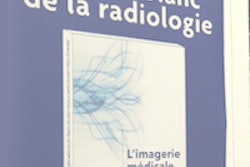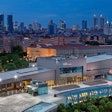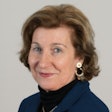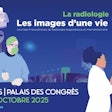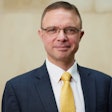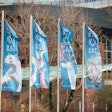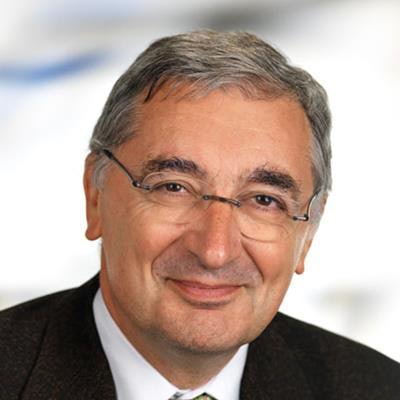
A name change and a star-studded program that reflects political forces at play promise to bring fresh life to the upcoming French national radiology congress, to be held in Paris from 14 to 17 October, according to meeting President Dr. Yves Menu.
The new name of the annual congress, Journées Francophones de Radiologie Diagnostique et Interventionnelle (Francophone Congress of Diagnostic and Interventional Radiology, JFR), replaces Journées Françaises de Radiologie Diagnostique et Interventionnelle (French Congress of Diagnostic and Interventional Radiology) and is the second tweak to the meeting's title in the past four years.
The title is meant to reflect the event's growing international stature, said Menu, who flagged the increasing numbers of French-speaking foreign delegates in attendance each year.
Key themes: Oncology and sport
As is customary, JFR will again pivot on two main themes. This year's topics are oncology and sports imaging.
The Cancer Path taking place across the four-day meeting comprises 19 different courses dedicated to oncology imaging, with a spotlight on follow-up. The flagship is the Antoine Béclère session, in which former president of France's National Institute of Cancer (Institut National de Cancer), Dr. Agnès Buzyn, will respond to questions from members of France's national radiological society, the SFR.
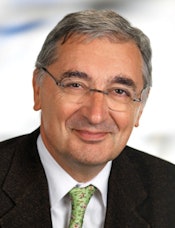 The Ministry of Health must understand the clinical role of imaging specialists, Dr. Yves Menu said.
The Ministry of Health must understand the clinical role of imaging specialists, Dr. Yves Menu said.Departing from the usual format of scientific and plenary sessions, whereby a formal talk is followed by informal exchange with attendees, this lecture will be organized around preformulated questions and answers, and it will be interspersed with video clips to demonstrate the relevance of each issue to French radiologists. Buzyn, a hematologist and now president of France's Health Authority (Haute Autorité Sanitaire, HAS), has prepared the session with Menu, focusing on the issues of MRI equipment, imaging guidelines, and communication with patients.
"The delay to MRI exams remains stable in France, despite a doubling of scanners across the country. It is within Dr. Buzyn's remit to explain to politicians about evolving indications for MRI. The boost to MR units in recent years was based on indications five years ago. Science has moved on since then and this means that the time lag has not been reduced," Menu told AuntMinnieEurope.com ahead of the meeting.
He also stressed the importance that the health authority and SFR collaborate on responding to allegations by France's national auditing office, Cour des Comptes, that imaging guidelines are poorly organized. SFR rejects the statements regarding guidelines made in the office's report on medical imaging published in May 2016, and it hopes HAS and SFR can work together to make existing guidelines more visible.
"We need to formulate a road map for guidelines on imaging, following this misleading public spending report," Menu stated.
Patient power
A highlight of the Antoine Béclère session will be video interviews with six radiology patients, recorded earlier this month. Of note were discoveries that most of the patients didn't know images could be shared between doctors at their institutes or the difference between a nurse and a technician. Menu was so impressed by the exchange that he has decided to use this interviewing process as a teaching tool for his residents at Saint-Antoine Hospital in Paris.
"These patients had a lot to say about their experiences, from the way they were welcomed to the department to what they wanted. It was clear that all desired more communication and radiologist visibility. They unanimously wanted the sense that an organization was looking after them," he explained.
However, Menu pointed to a strategy of high patient throughput expected from French radiology departments, which hampered face time.
"HAS can help to explain to the Ministry of Health that radiologists are involved in communicating with patients and have a clinical role, but that this eats up procedure time and may not fit with their view of financial optimization via maximized daily exam numbers," he said. "Furthermore, multidisciplinary teamwork remains nonreimbursed and unrecognized; this is another area that needs addressing. I hope that the session will provide an opportunity to share our clinical work with HAS, a chance to discuss the balance between quantity and quality, and a trigger to stop the numbers game."
In short, SFR will be asking HAS for partnership, according to Menu.
From cancer imaging, the congress will each day swing full circle to imaging the seemingly fit and healthy. Sports imaging in France is gaining greater prominence, particularly in an age when footballers may lose millions from their price tags depending on the results of a knee or ankle exam prior to signing. But this topic is not just about imaging the rich and famous, he said.
Eight scientific sessions aim to educate delegates on diagnosing the hidden congenital diseases and abnormalities of young athletes, pathologies related to brain trauma among boxers, and even the radiological signs of doping. The sessions are likely to focus on functional imaging and will each boast a panel comprising a sporting professional from the worlds of rugby, golf, and boxing among others, as well as a radiologist and a clinician. The plenary session will be presented by Claude Onesta, the coach of France's champion handball team.
Outside of France
Among JFR's guest countries this year are Belgium and South Korea. For the South Korean specialists and the contingent of Flemish-speakers from the Belgian delegation, the lingua franca will be English. The 12 South Korean speakers will cover a range of subspecialty topics, including chest, neurological, musculoskeletal, and abdominal imaging.
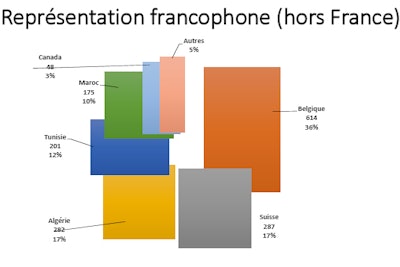 Attendance by French-speaking delegates from overseas caused JFR's organizers to rename the meeting. Chart shows 2015 JFR attendance statistics for French-speaking delegates from outside of France. Graphic translation, starting at top green section and moving clockwise: Morocco, Canada, Others, Belgium, Switzerland, Algeria, Tunisia. All graphs courtesy of SFR.
Attendance by French-speaking delegates from overseas caused JFR's organizers to rename the meeting. Chart shows 2015 JFR attendance statistics for French-speaking delegates from outside of France. Graphic translation, starting at top green section and moving clockwise: Morocco, Canada, Others, Belgium, Switzerland, Algeria, Tunisia. All graphs courtesy of SFR."We want to promote the possibility of using English, even though French remains the main common language," Menu stated. "Our courses in English are always well-attended; particularly the customary courses presented each year by the U.S. Air Force Institute of Pathology. This year's U.S. courses will cover chest, pelvis, and urogenital imaging. A few other seminars may have simultaneous French to English translation. Today the quality of the presentation is far more important for attendees than the language."
 Chart shows 2015 JFR attendance statistics for foreign delegates by geographical zone. Translation, starting at top green section and moving clockwise: North Africa, Middle East, Africa, Central and South America, North America (U.S. and Canada), Asia and Oceania, and Europe.
Chart shows 2015 JFR attendance statistics for foreign delegates by geographical zone. Translation, starting at top green section and moving clockwise: North Africa, Middle East, Africa, Central and South America, North America (U.S. and Canada), Asia and Oceania, and Europe.Menu also pointed to common sessions with the Canadian Society of Radiology and the College of Radiology of South America. He underlined the increase in attendance from Argentina and Brazil and also the rise in delegate numbers from Asia, which helped to fix JFR 2016 as an international event.

